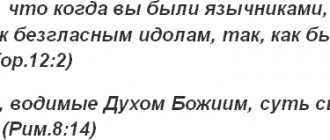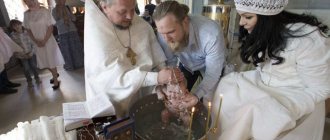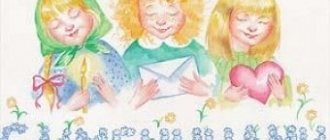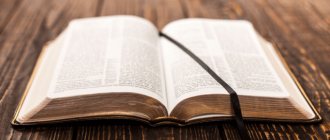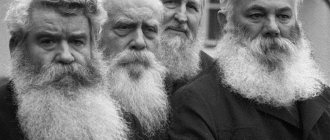“The Jews have the Torah, and we have the Bible,” such words betray an ignoramus in matters of religion. Moreover, this is a mistake not in some “higher mathematics” of theology, but a very serious mistake at the “kindergarten” level. It is worth remembering with what ardor and fervor the apostles defended every letter of Christ’s teaching!
To begin with, it is useful for a Christian believer to acquire at least basic knowledge of the Holy Scriptures. The Torah and the Bible are inextricably linked.
The Torah laid the foundation for Christian teaching.
It won't hurt us to understand what it is in order to know the origins of our religion.
Torah - the first five books of the Bible
It is incorrect to contrast the Torah with the Bible and ask what the difference is. The Torah is part of the Bible, its beginning.
The Bible is a collection of writings. It differs among Christian denominations. In the Russian Orthodox edition there are 77 books in it. In Greek - 76. For Catholics - 73. For Protestants - in different ways, but most often 66.
The Torah is the first five books of the Bible. This is the core from which several religious traditions originate. First of all, Judaism. And also Christianity. The events described in the Torah are reproduced in the Koran, so in a sense, Islam also inherits the content of the Torah.
Edition of the Torah with detailed commentaries
Tonah. In ancient times, even before all other biblical texts, only the Torah existed. Both the Old Testament and the New Testament appeared later as a continuation of this book. Until now, it is the main Holy Scripture for Jews, while for Christians the central place is occupied by the four Gospel texts. In Judaism, there are no New Testament manuscripts. Jews recognize only the Old Testament part of the Bible. They call it Tonakh.
Talmud. Another important body of texts for Jews is the Talmud. Both the Torah and the message of the Old Testament are commented on in detail. The result was a multi-volume publication with moral, everyday, religious and legal rules for Jews. Jewish teachers created this text over the course of six hundred years. It was written in Palestine and Babylonia, which is why there are two versions of the text. Sometimes they differ in content. Preference is often given to the Babylonian version.
So what did the Jews call their Holy Scripture? The first five books are the Torah, the entire Old Testament is Tonach, and the multi-volume commentary on them is the Talmud.
The Talmud is a very large commentary on the Compiled Scripture of the Jews - Tonach (Old Testament)
What is Torah
Torah is the Holy Book for Jews. It tells how they were called to be witnesses of the word of God, the trials they had to overcome, and the teachings that guided how they should live their lives to please God.
The Torah includes five Books and the Oral Torah, embodied in the Talmud and Midrash, which contain rabbinic teachings passed on to younger generations. Without the Oral Torah, the Written Torah can be misunderstood and misread. There is a whole ceremony for reading the Torah. First, the scroll is removed with the recitation of a special melody written on the scroll called Sefer Torah.
This melody was written by hand with special care and precision in all places of the document. No translations or interpretations are acceptable; not even a single letter or sign can be changed. Jews believe that every symbol and line inscribed there has a meaning, so scribes must be especially careful and precise when copying the Sefer Torah. They must have the highest qualifications. Torah translated from the Holy Language means “instruction for action”, “teaching”. It is the oldest of theological works.
The author of the Torah is considered to be the prophet Moses; he lived between the 16th and 13th centuries BC.
Prophet Moses. He is considered the author of the Torah.
Moses is considered to be the author of the Torah.
The personality of this prophet is known from several sources:
The Torah itself
"Antiquities of the Jews" by Josephus - a historical work
The Book of Jubilees - Old Testament apocrypha
Koran
There are also apocrypha, like the “Revelation of Moses,” but they are not very informative. Tradition tells that Moses, as a Jewish child, was taken into the family of an Egyptian princess in infancy. He was raised there.
However, God called Moses to leave Egypt and become the head of the Jewish people. During this journey, as is commonly believed, Moses wrote the Torah.
Edouard Schure, French writer who suggested that Moses was an Egyptian priest
Alternative versions are also expressed. For example, E. Shure in the book “Great Initiates” sets out the theory according to which Moses is an Egyptian priest.
There is an assumption that Moses is a collective image.
It is impossible to unambiguously determine the time of Moses' life. According to various assumptions, this is the 16th–13th centuries BC.
Josephus states that the princess who sheltered Moses was Hatshepsut, the female pharaoh. She lived approximately from 1504 to 1458. If Josephus is right, then the baby Moses could have been born somewhere in between.
Statue of female pharaoh Hatshepsut. She could have raised Moses, the author of the Torah
The prophet wrote the Torah in old age. He lived 120 years. Accordingly, the first texts of the Bible appeared in the 15th–14th centuries BC.
What are the Talmud and the Torah and how do they differ from the Bible?
https://arzamas.academy/mag/342-jews
Questions about Judaism
Everyone knows that Judaism is the religion of the Jewish people, but not everyone knows how it differs from other national religions, why a religious Jew cannot walk under an umbrella on a rainy Saturday, what a synagogue is and when the Messiah will finally come
Who can practice Judaism
There are two ways to become a Jew. The first is to be born to a Jewish mother, the second is to convert, that is, convert to Judaism. This distinguishes Judaism from Hinduism and other national religions - Zoroastrianism, Shintoism. You cannot accept Hinduism or Shintoism: you can belong to these religions only by birthright, but Judaism is possible. True, becoming a Jew is not so easy. According to tradition, a potential proselyte, that is, a person who has turned to a new religion, is dissuaded from this step for a long time so that he or she demonstrates the firmness of their intentions: “Anyone who wants to become a Jew is not accepted immediately. They say to him: “Why do you need to become a Jew?” After all, you see that this people is humiliated and oppressed more than all other peoples, how illnesses and troubles fall on them...” And although the quoted treatise “Gerim” (from Hebrew “Proselytes”) was created in the 2nd century - during the period when the Roman the authorities, taking revenge on the Jews for another anti-Roman uprising in Palestine, prohibited the performance of Jewish rituals - the warning sounding in it remained relevant at least until the middle of the twentieth century. The “applicant” who has shown the proper determination undergoes a special ceremony and becomes part of the Jewish people.
Brit Milah and Bar Mitzvah
So, for a proselyte, Jewish life begins with conversion. During this ritual, both men and women perform a ritual bath in a special pool - a mikveh. Men also undergo the rite of circumcision - Brit Milah. This ancient tradition, according to the Bible, dates back to the first Jew, Abraham, who first performed the ritual to commemorate the covenant made between him and God. Abraham was 99 years old - therefore, it is never too late to become a Jew. It is customary for boys born into Jewish families to be circumcised on the eighth day after birth.
The next important rite of life is the bar mitzvah (literally “son of the commandment”), which boys undergo when they reach 13 years of age. From this age onwards, males are considered old enough to comply with all the laws of Judaism. A similar rite for girls, bat mitzvah (“daughter of the commandment”), appeared relatively recently, at the end of the 19th - beginning of the 20th century, and was initially performed only in liberal religious circles, which, following the “spirit of the times,” sought to equalize the rights of women and men. This ritual had many opponents, but gradually it became generally accepted and today is performed in most Jewish religious families. During a bar mitzvah, a boy reads a chapter of Holy Scripture (Torah) publicly for the first time in his life. A bat mitzvah depends on the degree of liberality of the community: it is either also a reading aloud from the Torah, or a modest holiday with family.
How many commandments must Jews keep?
Everyone knows about the existence of the so-called Decalogue - the Ten Biblical Commandments (Exodus 19:10-25). In fact, Judaism makes much more stringent demands on its followers - Jews must keep 613 commandments. According to tradition, 365 are prohibitive (according to the number of days in a year), the remaining 248 (according to the number of organs of the human body) are prescriptive. From the point of view of Judaism, all non-Jews are required to do is to observe the seven commandments of the descendants of Noah (which, obviously, includes all of humanity). Here they are: the prohibition of idolatry, blasphemy, bloodshed, theft, incest and the consumption of meat cut from a living animal, as well as the requirement to establish a fair legal system. The great Jewish sage Maimonides, who lived in the 12th century, argued that non-Jews who observe these laws will enter the Kingdom of Heaven along with the Jews.
Why don't Jews eat pork?
Food prohibitions in Judaism are not limited to pork - the range of prohibited foods is quite wide. Their list is given in the biblical book of Leviticus. In particular, camel, jerboa, pig, most birds and fish without scales are prohibited for consumption. The nature of Jewish food prohibitions is a topic of heated debate, although from the point of view of Judaism, food prohibitions are a given, in which there is no point in looking for a rational grain. And yet even the famous Jewish sages tried to find explanations for them. Maimonides argued that foods forbidden to Jews were unhealthy. Another outstanding sage Nahmanides, who lived a century later, objected to him, arguing that such food is harmful primarily to the soul: the meat of birds of prey, for example, has a bad effect on a person’s character.
Why does a Jew need hair?
One of the distinctive features of the external appearance of a religious Jew, of course, is the sidelocks - long strands of hair at the temples. The fact is that one of the commandments orders men not to cut their hair at the temples - however, the length of hair is not regulated by this commandment, but depends on the traditions of a particular community. By the way, it is not customary for boys to cut their hair until they are three years old. But married women not only have to cut their hair short (in some communities even shave it off), but also hide it under a headdress. Some communities allow the wearing of wigs instead of hats, while in others this is strictly prohibited, since even artificial hair can seduce strangers.
What not to do on Saturday
Honoring the Sabbath is one of the main commandments of Judaism. The Bible tells us that God created the world in six days, and on the seventh day he “rested from his work.” In imitation of God, the Jews were ordered to sanctify the Sabbath day, freeing it from everyday work. What types of activities are prohibited? Some of them are listed in the Bible: you cannot light a fire, pitch a tent, or shear sheep. Later prohibitions, as a rule, are derived from biblical ones: you cannot turn on the electricity, open an umbrella (it looks like a tent, after all), shave your beard, etc. In the Jewish towns of Eastern Europe, there was a practice, if necessary, to engage in work prohibited in Saturday, Christian neighbors, who were called “shabes goyim” - “Sabbath foreigners.” It is also forbidden to bury the dead on Saturday, despite the tradition of interring the body of the deceased as soon as possible. However, contrary to popular belief, the Sabbath is not only possible, but must be broken in order to save one’s own or someone else’s life: “You can break the Sabbath for the sake of a child who is a day old, but not for the sake of the dead body of the king of Israel.”
When will the Messiah come
In Judaism, there is an idea that one day the Savior will come to the world - an ideal king, a descendant of King David, who ruled in the 11th century BC. e., Messiah (from Hebrew “mashiach” - “anointed one”). For centuries, Jews associated with his arrival the hope of changing their often disastrous situation, restoring the former greatness of Israel and returning to their historical homeland. It is not surprising that messianic expectations intensified in an era of political cataclysms. As you know, Christians believe that the Messiah has already come - this is Jesus Christ (translated from Greek, “Christ” also means “anointed one”), a carpenter from the city of Nazareth. In Jewish history there were other contenders for the role of “that same Messiah” - Bar Kochba (2nd century AD), Shabtai Zevi (17th century), Jacob Frank (18th century), but the hopes associated with them were disappointed, therefore the Jews continue to wait.
What are the Talmud and the Torah and how do they differ from the Bible?
Let's start with the fact that the Jewish Bible is not identical to the Christian Bible. The Christian one consists of two parts - the Old and New Testaments. The Old Testament (39 books) is exactly identical to the Jewish Bible, but the books are arranged in a slightly different order, and some of them are presented in a different edition. The Jews themselves prefer to call their Holy Scripture “TaNaKh” - this is an abbreviation formed from the first letters of the names of its parts. In a Jewish context, the name “Old Testament” should not be used, since for the Jews their covenant with God is the only and relevant one. Another word that is often used to designate Holy Scripture in Judaism is Torah (Law). This term is used in different meanings: this is the name of the first five books of the Bible (the Pentateuch of Moses), but sometimes the Bible as a whole, and even the entire body of Jewish laws.
The word “Talmud” in the Russian language has acquired a common noun character - this can be the name of any thick book. However, in Judaism, the Talmud (from Hebrew “teaching”) is not just a thick, but a very thick book - it is a monument to medieval Jewish thought, a set of legal, ethical and ritual norms of Judaism. The texts of the Talmud represent discussions of authoritative sages on various issues from all spheres of life - agriculture, religious holidays and rituals, family relationships, criminal law, etc. The Talmud is several times larger in volume than the Bible and complements it. The high status of the Talmud in Judaism is ensured by the idea that it is based on the Oral Law (or Oral Torah), which, like the Torah itself, was given by God to the prophet Moses on Mount Sinai. The Torah was given in written form; The Oral Law, as its name suggests, is oral. It was in oral form that it was transmitted from generation to generation, discussed and commented on by the sages, until it was finally written down.
Judaism or Judaisms
Modern Judaism is a heterogeneous phenomenon. In addition to the most traditional Orthodox Judaism, there are other, more liberal movements. Orthodox Judaism, by the way, is also heterogeneous. In the 18th century, a special movement appeared in Eastern Europe - Hasidism. At first it was in confrontation with traditional Judaism: its adherents sought not so much the traditional intellectual knowledge of God through the study of the Holy Scriptures, but rather the emotional and mystical one. Hasidism is divided into several directions, each of which goes back to one or another charismatic leader - a tzaddik. Tzadikim were revered by their followers as holy righteous people, mediators between God and people, capable of performing miracles. Hasidism spread quite quickly throughout Eastern Europe, but failed in Lithuania thanks to the efforts of the spiritual leader of Lithuanian Jews - the outstanding Rabbi Eliyahu ben Shlomo Zalman, nicknamed the Genius of Vilna, or Gaon in Hebrew, for his wisdom. Thus, opponents of Hasidism began to be called Litvaks, regardless of their place of residence. Over time, the contradictions between Hasidim and Litvaks have lost their severity, and now they coexist quite peacefully.
A more liberal movement - the so-called Reformed Judaism - arose in the 19th century in Germany; his followers sought to make the Jewish religion more European and thereby promote the integration of Jews into European society: to translate worship from Hebrew into German, to use an organ in worship, to abandon prayers for the return of the Jewish people to Palestine. Even the vestments of a Reform rabbi became almost indistinguishable from those of a Lutheran pastor. The most radical supporters of reformism advocated moving the day of rest from Saturday to Sunday. It was within Reform Judaism that the first female rabbi emerged in the 1930s, and today even allows same-sex marriage. Reformism is popular in the USA. There are also Reform communities in Europe, Latin America and Israel, but their popularity is much lower.
At the beginning of the twentieth century, Conservative Judaism emerged in the United States, taking an intermediate position between Orthodox and Reformed. Conservatives sought more moderate and gradual changes than Reformists: they insisted on maintaining Hebrew as the language of worship, strict adherence to food prohibitions and Sabbath rest. Later, contradictory tendencies appeared in Conservative Judaism - some of its adherents sought to get closer to the Reformists; others, on the contrary, drifted towards the orthodox. Today, the Conservative version of Judaism is still quite popular in the United States, and there are a small number of communities in Israel.
Scientists believe that the Torah was written no earlier than VIII based on four sources
VIII
The earliest date of the appearance of Thor
Scientists believe that the Torah appeared much later. The earliest possible date for the appearance of this text is called the 8th century BC. Analysis of the texts indicates that it was written based on materials from four sources. Conventionally they are called:
Yahwist
Elohist
Holy Code
Deuteronomy
Each of these documents has its own topic and its own style of presentation. They are recognizable in style and meaning in the Torah. The dating of the sources themselves is a controversial issue. Most researchers are inclined to believe that the first books of the Bible existed first in the oral tradition, and were written down much later.
It is possible to reconcile tradition and science with the version that Moses is the author of the Torah, but it was written down not by him, but by his descendants on the basis of oral tradition. Moreover, it is most likely that the text has gone through many edits and distortions. There are many logical contradictions in the Torah; the same stories are often repeated and presented in different ways.
Joshua (one of the supposed authors of the Torah)
The fact that Moses did not write the Torah is also supported by the fact that his death is described in Deuteronomy. It is popularly believed that Joshua wrote the ending of the last book of the Torah. But this version does not suit everyone. Orthodox Jews are convinced that only Moses could have written such a sacred text. He is considered powerful enough to know in advance about his death.
The Bible came from the Torah
It is believed that the Bible was created on the basis of the Torah, but throughout its existence it has been subject to various correction systems that benefit certain people. Additional characters and events were added to the original Torah, thus creating the Bible, and even laws and requirements were edited. Jews and Muslims consider the Bible only free reading.
The original text of the Bible is confirmed by the Qumran finds. This is important in order to maintain the authenticity of this book. Christians call the Torah the Pentateuch of Moses. The Bible is recognized throughout the world. It has become the main book of humanity, where you can find answers to legal, economic, social, family issues, as well as questions related to education.
There is an apocryphal analogue of the Torah - the Book of Jubilees
Although the boom of apocryphal books occurred in the New Testament era, and they were written in Jewish times. The Torah, or rather the Book of Genesis, also has a double. Its earliest text is from the 2nd century BC. It's called the Book of Jubilees. How does this apocrypha differ from the Book of Genesis?
The story is told from the perspective of an angel.
The Book of Jubilees tells in detail about the rites and rituals of the Jews.
New parts available. For example, Adam and Eve have daughters - Avan and Azura.
Noah's Ark lands on Mount Lubar.
Comments
- Slav
:03/01/2019 at 00:42
But the difference is that in the Torah Jews are sons of God, and in the Bible goyim are servants of God, and who can tell the difference between sons and slaves?
Answer
- Sergey Uchaev
:
03/01/2019 at 00:44
And that’s the difference: in the Torah, Jews are sons of God, and in the Bible, goyim are servants of God, and now I’ll ask the question - what’s the difference between sons and slaves?
Answer
By leaving a comment, you accept the user agreement




